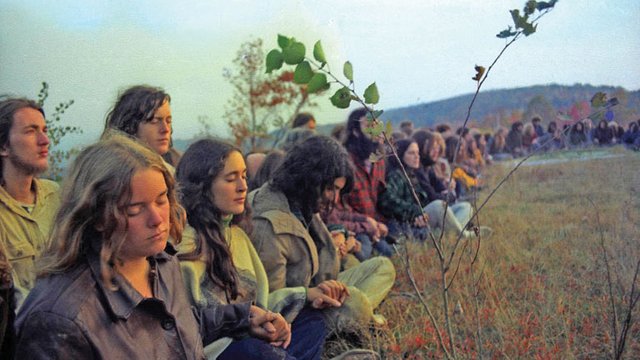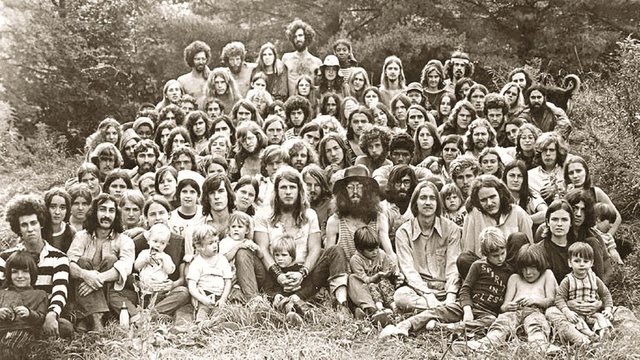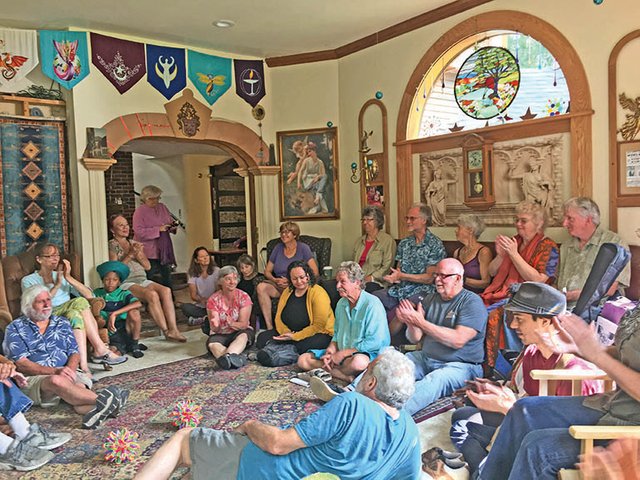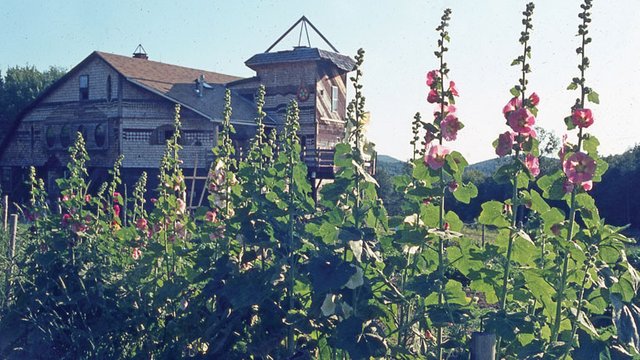Whatever Happened to the Renaissance Community?

Excerpted from the Fall 2019 edition of Communities, “The Shadow Side of Cooperation”—full issue available for download (by voluntary donation) here.

The April/May 1982 issue of Communities included a piece by Corinne McLaughlin and Gordon Davidson, founders of the Sirius Community in Shutesbury, Massachusetts, entitled “Heralds of the Dawn.” The somewhat grandiose title fit the mood of the fledgling New Age movement in which intentional spiritual communities would bring about a great positive change for humanity.
Included along with the Sirius Community, Abode of the Message, Ram Dass’s Lama Foundation, Ananda, and others was the Renaissance Community, the largest and longest-lasting commune in the Northeast. As each group was allowed several pages to describe itself, the Renaissance Community did so in the form of a photo essay, an appropriate choice considering its longstanding interest in creativity and the media.
According to the accompanying text, the community, located in Gill, a tiny hamlet in western Massachusetts, was populated by 100 adults and over 40 children and was in the process of building a self-sufficient village on its 80 acres of land. Plans abounded for orchards, fish farms, windmills, greenhouses, and homes heated by solar or wood hot water systems. At the time, Renaissance was involved in networking with other spiritual communities around the world and had established an exchange program with the venerable Findhorn Foundation in Scotland. Renaissance projected itself as an esoteric, yet grounded collective based on love, harmony, and cooperation. The article contained only one brief mention of the community’s mercurial founder, Michael Metelica (also known as Michael Rapunzel). Judging from the tone of the article, the future for the Renaissance Community looked bright and promising.
Within six years, it had fallen apart. What happened?
The Renaissance Community began as the most unintentional of intentional communities. In May 1968, inspired by the recent Summer of Love, the 18-year old Metelica constructed a treehouse on a patch of countryside known as Blueberry Hill in his tiny home town of Leyden, Massachusetts. He hired himself out for work to local farmers and asked for nothing in return. “I wanted to live by the purest of spiritual values,” Metelica said in a later interview, “I desired a solitary, meditative existence and had no plans to form any kind of commune.”
Before long, Metelica became a local attraction, who garnered notice in the county newspaper as the idealistic mystic in the woods. His school chums gravitated to him and soon committed themselves to follow his vision. When one of them wanted to bring his heroin-addicted girlfriend on board in order to get her clean, he consented to a deliberate community and assumed the role of nominal leader. After arsonists burnt down the treehouse, the small group of 20 men and women wandered through the hill towns nestled in the foothills of the Berkshire Mountains. Undeterred by their impoverished existence, the tiny tribe, now called the Brotherhood of the Spirit, explored their ideals of love and comradeship with a zeal that mirrored the era.
The Brotherhood finally settled onto a 40-acre property in the hinterlands of Warwick, Massachusetts in April 1970. Over the following summer, as young Americans engaged in a mass migration across the country, their membership tripled to 150. My sister Jenny was one who joined them. In her letters to me, she described her new abode as a place where “Everyone lived openly and honestly.” Her words reverberated as did the letter’s tone of near-mystical awe. In September 1970, I traveled to the Brotherhood to see her for a short overnight visit.

I left 14 years later.
The Brotherhood initially struck me as one intense group of people. Everybody broadcasted high-intensity beams of energy and exchanged no small talk, only deep personal interactions. Drugs, alcohol, and cigarettes were forbidden. I discovered no radios, no television, no magazines or newspapers. Even records were banned as the community was bent on spreading its spiritual credo through their house band, “Spirit in Flesh.” Cut off from worldly distractions, the Brotherhood was a perfect incubator for spiritual growth based on its philosophy that was a mix of Buddhism, Gnostic Christianity, and nascent New Age consciousness. Devotees accepted the precepts of karma and reincarnation, meditated often, and avidly read The Aquarian Gospel of Jesus the Christ, published in 1907 by an Ohio preacher named Levi Dowling.
Metelica and the Brotherhood were also guided by Elwood Babbitt, a trance medium in the Edgar Cayce tradition who had fought across the Pacific with the Marines during World War II. Babbitt enjoyed an elderly following of his own but took the younger folk under his tutelage. According to Babbitt’s spiritual entities, cataclysmic “Earth Changes” would soon alter the planet and depopulate most of the human race for its negative behavior. Those who survived would flock to the Brotherhood for succor and wisdom. Before this happened, supposedly in 1972, Spirit in Flesh would prepare the way by selling millions of albums and become more famous than the Beatles. The Brotherhood faithful accepted these doctrines without an ounce of doubt.
I spent my first winter there logging in 10 degree weather, a radical departure from my upscale New York City upbringing. Surprisingly, I liked it. Outdoors, we cut down trees for the wood furnace, sang our repertoire of communal songs, and did whatever we could to “Raise the energy” and push beyond our physical limits. The average age was 19. For the next few years after, I helped print thousands of silkscreened posters of Spirit in Flesh. In an attempt to promote the band, we pasted them on every vertical surface of New York City and across the nation. When the first album was released, it sold only 600 copies (but keeps popping up on eBay). About the same time, the Brotherhood published its own magazine, The Free Spirit Press. I drew artwork for it and sold copies out of our rainbow-painted school bus in shopping malls and college campuses across the Northeast. 1972 came and went without any global catastrophes. We shrugged our shoulders and continued our lives as before.
By mid-1973, the Brotherhood numbered 300 members and had appeared in The Wall Street Journal, Mademoiselle, and Family Circle magazines as well as televised segments on “60 Minutes” and “The David Frost Show.” Nobody in the community knew it at the time but our secluded rustic idyll was about to come to an end.
The community was unique in its ability to radically shift gears to meet changing needs. These shifts were traceable to Michael Metelica, who enjoyed an exalted status among his followers. Seemingly without fear, he was never shy to set a course into the unknown like some Aquarian-Age Magellan. He did so in style in the summer of 1973 when he called a group meeting and announced the following.
“The community is in serious financial trouble,” he said. “We’re about to go under. So, I’m giving you a choice. Either you allow me to take over the complete management of the Brotherhood or…”―a dramatic pause for effect―“I’ll leave and you can all take care of this problem yourselves.”
A gasp rattled the rafters. We knew it was unthinkable for Metelica to leave. So did he. His was a clever, calculated move, a form of manipulative democracy. Metelica called for a vote, hands up if we wanted him to remain. Not that he had to. Every hand shot up, mine included.
As with everything Metelica did, things began to happen very fast. He immediately abolished the Brotherhood of the Spirit and formed a “media corporation” called the “Metelica Aquarian Concept” (MAC). Everyone in the former Brotherhood had to “apply” for membership by filling out a 20-page application. Metelica bought a block of downtown property in the decaying mill town of Turners Falls which became our new nerve center. He sent every member out to find a job and turn over their paychecks to a central office. With these funds, Metelica went on a shopping spree, unheard of during the austere Warwick days. Video cameras, cars, motorcycles, fancier clothing, and furniture seemingly dropped out of the sky. The group also purchased an airplane, three GMC motorhomes, and several more properties in downtown Turners Falls for residences and businesses. Spirit in Flesh―the harbinger of the impending worldwide spiritual renaissance―ceased to exist. Warwick was abandoned and forgotten. From then on, we were no longer ragged spiritual hippies but slick, media-savvy entrepreneurs.
Through this change, we entered what I called our “Cult Period.” Insidiously, the focus began to shift away from the community and onto Metelica. The pronoun used among us became “He,” not “We.” Metelica promoted his own omnipotence and divided the community into a brittle hierarchy that assigned members to separate living quarters while wearing a particular sweater color to denote rank in the new order. In 1974, MAC became the Renaissance Community and the Renaissance Church, both legal bodies with Metelica as an ordained minister of the latter. As we gained more power and wealth, resistance from the mainstream society resulted in the murder of one of our members, a crime that was never solved. Metelica added fuel to the tension by having his followers stage somber marches in the local communities carrying signs that testified “I Found Metelica, a New Religion,” “Invest in Metelica for a Brighter Future,” and more threateningly, “Save Your Slander, It May Be All You’ve Got. I’ve Got Metelica.” Metelica’s rationale was that such a display of devotion would win us respect from the general public, but it most likely scared them into thinking we were the latest manifestation of the Manson Family.
On the positive side, Renaissance improved its infrastructure and launched an explosion of creativity that allowed members to explore music, dance, art, photography, and video production with state-of-the-art equipment. It was during this time that I became a photographer, having high-end Canon SLR cameras and a darkroom at my disposal. Downtown Turners Falls, previously deserted, became a hive of activity as the storefronts filled with twelve Renaissance businesses―three of which, Renaissance Greeting Cards, Rockets Silver Train tour bus, and Silver Screen Design, would become national enterprises. A popular restaurant, The Noble Feast, offered a diverse menu and ornate décor that mimicked Carlsbad Caverns. At the same juncture, dozens of Renaissance personnel worked at Belchertown State School, an institution once described as “barbaric,” bringing a level of humanity to those who were incarcerated there. The founder of The Farm, Stephen Gaskin, visiting Renaissance in 1975 but unimpressed by our new materialistic identity, remarked, “The only reason you people still exist is because of the good karma you’ve earned from working at Belchertown.”
The cult-like atmosphere eventually receded as community members achieved autonomy through managing their own businesses and raising nuclear families. The hierarchy of sweaters disappeared. The community launched a series of free public dinners, concerts, and street festivals culminating in the “Renaissance Faire” that drew thousands of people to downtown Turners Falls. Such outreach lessened the public reaction against us. Likewise, we toned down our “world savior” rhetoric in order to be seen as no more threatening than the Shakers or the Amish.

Change struck again in late 1975, as Metelica decided that it was time to get back to the land and create a self-sufficient village named “The 2001 Center.” Slowly, enterprises and personnel transferred out of Turners Falls to an 80-acre parcel in nearby Gill. Work on the alternative energy houses began immediately as by now, community members had amassed an impressive array of professional and technical skills. A mutual exchange program with Findhorn resulted in founders Peter Caddy and Dorothy Maclean giving a series of public lectures at Renaissance in 1978. Returning back to the land allowed us a brief period of harmony before our final slide into disintegration.
Unbeknownst to many of us, Metelica had descended into a deep cocaine and alcohol addiction. Those in his inner circle were the first to become alarmed but when they issued warnings and were subsequently ignored, they departed. This piecemeal migration continued as the community divided into two adversarial factions: one supporting and one challenging Metelica’s authority. In late 1980, about 60 core members, including the Renaissance Greeting Cards business, which handled the finances Metelica was draining with his cocaine use, decided to go their own way. It was a fracture from which Renaissance never recovered as our morale and people-power were severely diminished.
The remaining members closed ranks and soldiered on for a few years as the group continued construction of its self-sufficient village and to network with other like-minded communities in the Northeast. New members replaced the old although many were drawn merely for a free meal and roof over their heads. Alcoholism and periodic violence became new afflictions. Meanwhile, former members (who now outnumbered those who remained) created their own annual reunion network and newsletters in which they vented emotions which ranged from nostalgia to betrayal.
I supported Metelica during this period only because he had always been kind to me and offered advice at critical moments that changed my life for the better. I chose to tolerate his erratic behavior, assuming the mission statement of the community could override his depredations. I was wrong.
A year after I co-wrote the glowing piece for Communities, I learned of Metelica’s plan to bring guns into The 2001 Center and set up a rifle range. For me, guns were the final boundary the community could not cross without losing whatever moral integrity that remained. On the first day we met years before, Metelica had told me, “Remember, Dan, standing up for the truth is more important than friendship.” I knew it was time to put that axiom into practice and confronted him at his apartment down by the tour bus garage.
I didn’t bother to knock on his door. Any hesitation would have caused me to lose my nerve. Metelica was seated at the kitchen table listening to a tape of AC-DC. Before he saw me, I shut off the player and shouted, “What the hell do we need guns for anyway?” Metelica whirled around, his disheveled hair flying. He was dressed in a ragged T-shirt and faded jeans. His mouth dropped as if a cinderblock had begun to speak. In 14 years, he had rarely if ever heard me complete a phrase in his presence. He shook off his surprise, leapt up, and leaned over me. “Because Elwood said when the refugees come after Earth Changes, we'll have to shoot them to defend ourselves. Now, get out of here!” His breath stank of stale beer.
I left him feeling shocked, and the next day shared my doubts with our erstwhile guru Elwood Babbitt who, over the past years, had distanced himself from the community. He shook his head when I told him about the guns and told me that Metelica had spiraled down a negative path and wanted nothing more to do with him. As he spoke, his voice shook with loathing.
As I was not alone in my outrage over Metelica, the final exodus of long-term members departed with me in June 1984. Afterwards, Renaissance degenerated into physical squalor as the land itself visibly deteriorated and Metelica became more unstable. By 1988, even those who had enabled him to the bitter end had had enough. The remaining dozen members paid Metelica $10,000 to leave the community and never return. He departed and resettled in upstate New York.
With him gone, the survivors began a long recovery process. The Renaissance Community rescinded its legal status and divided up the land into private ownership and rental apartments. Reunions of past and current members became biennial events and renewed the original feeling of camaraderie. A few residents in Gill established meditation and spiritual awareness classes on the property that attracted a dedicated local following.
Metelica, meanwhile, cleaned himself up at Alcoholics Anonymous and became a licensed EMT. In May 2002, he was diagnosed with terminal colon cancer. A month later, a “pre-funeral” gathering was held for him. Over a hundred Renaissance veterans attended, some connecting with Metelica for the first time since their bitter departure years before. Michael Metelica passed away in February 2003.

In 2006, a documentary film about the community, “Free Spirits, the Birth, Life and Loss of a New Age Dream” was released and played to a full house at the stately Academy of Music Theater in Northampton, Massachusetts. Nearly all the members of the Renaissance Community attended and gave the director/producer (and former Renaissance member) a standing ovation. Over the summer of 2018, the Renaissance Community held its 50th anniversary reunion, a weekend affair that drew former participants from all over the country.
Fifty-odd years after its creation, we of the Renaissance Community are still coming to terms with our shared experience but without a clear consensus. Some have rejected both communal living and a spiritual worldview as naïve experiments of their youth. Others believe that they were brainwashed from the beginning by a corrupt manipulator. Most of us, however, cherish our time in the community although we are honest as to why it failed. The lethal combination of power, ego, and spirituality has claimed its share of victims and the saga of the Renaissance Community is hardly unique. I find it ironic that when asked to relinquish power, Peter Caddy agreed and, thus, the Findhorn Foundation exists to this day. When given the same challenge to step down, Michael Metelica refused and destroyed his own creation.
Myself, I still hold the spiritual principles of the Brotherhood to be valid and have since enjoyed a rich and multi-creative life. Among other attributes garnered from the community, having learned to adapt to a diversity of personalities has positively influenced my career as a professional educator. The community was my “School of Life” and it was where I grew into adulthood.
In the end, those of us who chose this path cannot deny that without Michael Metelica and the Renaissance Community, the lives of all involved would have been radically different. Our association with it resulted in finding our best friends, not to mention life-partners, children, and livelihoods. In view of those connections, the Renaissance Community cannot be seen as a failure but as a growth experience that made us better people.
Daniel A. Brown was born in New York City in 1950. He lived at the Brotherhood of the Spirit/Renaissance Community from 1970-1984 and is one of its archivists-history keepers. Since leaving Renaissance, Brown has been a classroom teacher, general aviation pilot, drum circle leader, published author, and exhibition artist and photographer. He currently lives in Taos, New Mexico with his wife, Lisa and dog, Cody. Brown’s artwork can be seen at www.intothewildblue.com.
Excerpted from the Fall 2019 edition of Communities, “The Shadow Side of Cooperation”—full issue available for download (by voluntary donation) here.

Posted from my blog with SteemPress : https://www.ic.org/whatever-happened-to-the-renaissance-community/
Source
Copying and pasting previous posts or significant parts there of could be seen as spam when:
Spam is discouraged by the community and may result in the account being Blacklisted.
Please refrain from copying and pasting previous posts going forward. If you believe this comment is in error, please contact us in #disputes on Discord